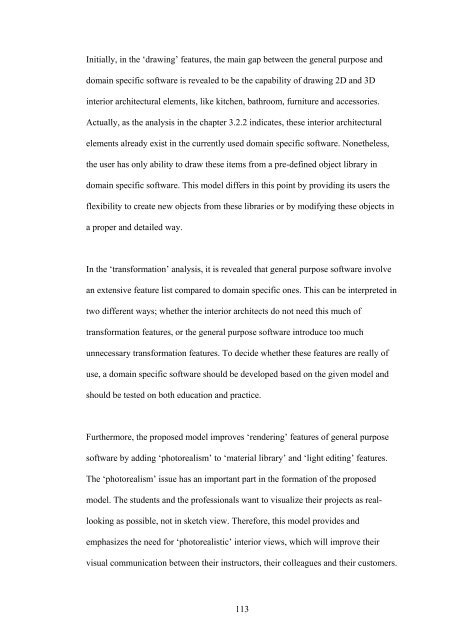critical analysis of the absence of interior - Bilkent University
critical analysis of the absence of interior - Bilkent University
critical analysis of the absence of interior - Bilkent University
Create successful ePaper yourself
Turn your PDF publications into a flip-book with our unique Google optimized e-Paper software.
Initially, in <strong>the</strong> ‘drawing’ features, <strong>the</strong> main gap between <strong>the</strong> general purpose and<br />
domain specific s<strong>of</strong>tware is revealed to be <strong>the</strong> capability <strong>of</strong> drawing 2D and 3D<br />
<strong>interior</strong> architectural elements, like kitchen, bathroom, furniture and accessories.<br />
Actually, as <strong>the</strong> <strong>analysis</strong> in <strong>the</strong> chapter 3.2.2 indicates, <strong>the</strong>se <strong>interior</strong> architectural<br />
elements already exist in <strong>the</strong> currently used domain specific s<strong>of</strong>tware. None<strong>the</strong>less,<br />
<strong>the</strong> user has only ability to draw <strong>the</strong>se items from a pre-defined object library in<br />
domain specific s<strong>of</strong>tware. This model differs in this point by providing its users <strong>the</strong><br />
flexibility to create new objects from <strong>the</strong>se libraries or by modifying <strong>the</strong>se objects in<br />
a proper and detailed way.<br />
In <strong>the</strong> ‘transformation’ <strong>analysis</strong>, it is revealed that general purpose s<strong>of</strong>tware involve<br />
an extensive feature list compared to domain specific ones. This can be interpreted in<br />
two different ways; whe<strong>the</strong>r <strong>the</strong> <strong>interior</strong> architects do not need this much <strong>of</strong><br />
transformation features, or <strong>the</strong> general purpose s<strong>of</strong>tware introduce too much<br />
unnecessary transformation features. To decide whe<strong>the</strong>r <strong>the</strong>se features are really <strong>of</strong><br />
use, a domain specific s<strong>of</strong>tware should be developed based on <strong>the</strong> given model and<br />
should be tested on both education and practice.<br />
Fur<strong>the</strong>rmore, <strong>the</strong> proposed model improves ‘rendering’ features <strong>of</strong> general purpose<br />
s<strong>of</strong>tware by adding ‘photorealism’ to ‘material library’ and ‘light editing’ features.<br />
The ‘photorealism’ issue has an important part in <strong>the</strong> formation <strong>of</strong> <strong>the</strong> proposed<br />
model. The students and <strong>the</strong> pr<strong>of</strong>essionals want to visualize <strong>the</strong>ir projects as real-<br />
looking as possible, not in sketch view. Therefore, this model provides and<br />
emphasizes <strong>the</strong> need for ‘photorealistic’ <strong>interior</strong> views, which will improve <strong>the</strong>ir<br />
visual communication between <strong>the</strong>ir instructors, <strong>the</strong>ir colleagues and <strong>the</strong>ir customers.<br />
113
















